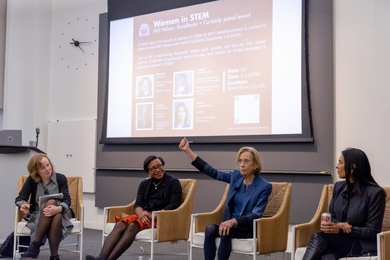To the members of the MIT community:
On December 16 the Institute-wide Planning Task Force released its final report. Today we write to describe how we will act on and advance the ideas presented in this report, which marked the culmination of an intense period of collaboration that began one year ago. The final report proves, once again, that MIT is at its best when it comes together to solve problems. This extraordinary effort brought together approximately 200 faculty, students, and staff to develop and assess ideas, and to explore new ways of reducing costs and enhancing revenues while promoting MIT's historic excellence. Many of these ideas grew out of submissions to the online Idea Bank, which encouraged and facilitated the participation of the entire MIT-wide community. In addition, the Task Force was able to build on and accelerate many long-standing efforts across the Institute aimed at improving our operations and strengthening MIT's global leadership.
We have seriously considered all ideas presented by the Task Force Working Groups while planning for Fiscal 2011. The ideas and recommendations put forward by the Task Force respond to our original charge, and range from operational improvements to strategic opportunities, from relatively simple changes to very complex implementations, and from incremental actions to bold and ambitious statements. All of these recommendations are proposals for change. In evaluating these proposals, we must carefully consider the impact of possible changes on the MIT culture, and reaffirm our commitment to the guiding principles that have helped to make MIT a great institution. Progress, at this or any time, requires change.
Our guiding principles include commitment to a unified structure of one faculty, staff and student population that operates under a common set of policies and procedures, and to working and communicating with the entire MIT community. The Task Force outcomes are a reflection of these principles in action. We have witnessed with pride this collective work over the past year, and we are inspired by the outcome of this impressive effort. Before we move forward to act on the Task Force recommendations, we want to express our most sincere gratitude to every member of the MIT community for their dedication to this effort and to the Institute.
Moving Forward: Implementing and Advancing Task Force Ideas
After careful consideration of the ideas and recommendations included in the report, and guided by feedback from the MIT community and discussions with the Task Force Coordinating Team and Working Group Co-Chairs, we propose a roadmap for action focused on three objectives:
The work to balance the financial picture of MIT is unwavering. Thanks to the determined work of the MIT units, much has been accomplished in Fiscal 2010, but more is needed in Fiscal 2011. The planning objective for Fiscal 2011 is to be able to absorb the effects of the financial and economic crises and balance the general Institute budget (GIB). The Fiscal 2011 pro-forma budget includes a planned budget reduction of $61 million, in addition to the $58 million already achieved in the current Fiscal 2010. Additional information can be found at the Institute-wide Planning website, and a budget planning update can be found here.
The following Task Force ideas are estimated to contribute $12 million in budget savings or revenues and are incorporated in our Fiscal 2011 pro-forma budget.
2. Promoting and investing for the future
Equally important to improving the short-term financial picture of the Institute, is investing for the future of MIT. Many ideas and recommendations from the Task Force can be instrumental in creating a sustainable MIT, both physically and financially; we are making a commitment to promote, invest in and advance them.
We have asked the Task Force Coordinating Team — Vice President for Finance Israel Ruiz, Associate Provost Martin Schmidt, and Vice Chancellor and Dean for Graduate Education Steven Lerman — to continue in their role as we move from idea generation into the implementation phase of this work. We have also asked the Task Force Working Group Co-Chairs to continue to act in an advisory capacity to the Coordinating Team as ideas are further evaluated, so that we can be sure to retain the spirit and intent of their recommendations. We have asked them to develop a process to inform the selection of ideas and investment opportunities that will better position MIT to operate in a more sustainable way in the future in time to inform the final Fiscal 2011 budget.
The areas we consider of most interest are:
The Task Force recommended that a number of opportunities identified by the Working Groups be assigned to individual units and existing committees for further evaluation and to determine next steps. We recognize the value in pursuing additional ideas, and have followed this recommendation. A number of these ideas are already being explored by units across MIT, and some are in the early stages of implementation and will impact Fiscal 2011. These include improving the utilization of summer student housing, addressing expenditures for Athena clusters and printing, and providing electronic paystubs for the MIT community. In addition, we are charging several groups with continuing the work of the Task Force.
First, in order to effectively and efficiently evaluate the implementation possibilities and the timeline for these activities, we are asking the Task Force Coordinating Team to collect responses from unit leaders with assigned ideas by April 2nd, and to work together with the Working Group Co-Chair Advisory Group to determine next steps and prioritize ideas for implementation. As we work to prioritize this important work, we must evaluate each opportunity based on its potential impact to the MIT mission, financial sustainability, compatibility with our overall values and core principles, and with sensitivity to the particular groups affected, while also considering alternative approaches.
Second, in response to the feedback received on the ideas related to MIT's benefits program, we recently charged the Benefits Advisory Group to deepen the understanding of different proposals and to advise on potential options and implementation paths. The Group, which is chaired by Vice President for Human Resources Alison Alden, is expected to report its recommendations to MIT's senior leadership in June.
Third, we will appoint the following groups to further understand the opportunities described below and, if deemed desirable, to inform the appropriate level of investment. The groups will advise the Task Force Coordinating Team on possible implementation paths with preliminary reports due shortly after Commencement.
Sincerely,
L. Rafael Reif, Provost
Phillip L. Clay, Chancellor
Terry Stone, Executive Vice President & Treasurer
On December 16 the Institute-wide Planning Task Force released its final report. Today we write to describe how we will act on and advance the ideas presented in this report, which marked the culmination of an intense period of collaboration that began one year ago. The final report proves, once again, that MIT is at its best when it comes together to solve problems. This extraordinary effort brought together approximately 200 faculty, students, and staff to develop and assess ideas, and to explore new ways of reducing costs and enhancing revenues while promoting MIT's historic excellence. Many of these ideas grew out of submissions to the online Idea Bank, which encouraged and facilitated the participation of the entire MIT-wide community. In addition, the Task Force was able to build on and accelerate many long-standing efforts across the Institute aimed at improving our operations and strengthening MIT's global leadership.
We have seriously considered all ideas presented by the Task Force Working Groups while planning for Fiscal 2011. The ideas and recommendations put forward by the Task Force respond to our original charge, and range from operational improvements to strategic opportunities, from relatively simple changes to very complex implementations, and from incremental actions to bold and ambitious statements. All of these recommendations are proposals for change. In evaluating these proposals, we must carefully consider the impact of possible changes on the MIT culture, and reaffirm our commitment to the guiding principles that have helped to make MIT a great institution. Progress, at this or any time, requires change.
Our guiding principles include commitment to a unified structure of one faculty, staff and student population that operates under a common set of policies and procedures, and to working and communicating with the entire MIT community. The Task Force outcomes are a reflection of these principles in action. We have witnessed with pride this collective work over the past year, and we are inspired by the outcome of this impressive effort. Before we move forward to act on the Task Force recommendations, we want to express our most sincere gratitude to every member of the MIT community for their dedication to this effort and to the Institute.
Moving Forward: Implementing and Advancing Task Force Ideas
After careful consideration of the ideas and recommendations included in the report, and guided by feedback from the MIT community and discussions with the Task Force Coordinating Team and Working Group Co-Chairs, we propose a roadmap for action focused on three objectives:
- Impacting the Fiscal 2011 budget;
- Promoting and investing for the future; and
- Understanding implementation paths and options.
The work to balance the financial picture of MIT is unwavering. Thanks to the determined work of the MIT units, much has been accomplished in Fiscal 2010, but more is needed in Fiscal 2011. The planning objective for Fiscal 2011 is to be able to absorb the effects of the financial and economic crises and balance the general Institute budget (GIB). The Fiscal 2011 pro-forma budget includes a planned budget reduction of $61 million, in addition to the $58 million already achieved in the current Fiscal 2010. Additional information can be found at the Institute-wide Planning website, and a budget planning update can be found here.
The following Task Force ideas are estimated to contribute $12 million in budget savings or revenues and are incorporated in our Fiscal 2011 pro-forma budget.
- Advancement of procurement and sourcing recommendations and travel modernization. Examples include: (i) Combining campus purchasing volume with Lincoln Laboratory; (ii) Negotiating volume and market share discounts in exchange for upgraded supplier status in MIT's tools; (iii) Renegotiating travel services for airlines, hotels and cars, focusing on frequently traveled segments; and (iv) Introduction of MIT travel credit card, online booking tool, electronic expense reporting and direct deposit for out-of-pocket reimbursements;
- Investments and concrete actions in energy efficiencies. For example, modeling energy needs according to time of day, weather conditions, equipment constraints and predicted pricing for electricity in order to optimally deploy assets at the utility plant to meet demand in the most cost effective way;
- Increase in visitor fees to cover more of the associated costs;
- Modest increase in total undergraduate enrollment (target up by 50 students to 4,288); and
- Reduction in the student expense budget and adjustment of financial aid to better reflect true board costs.
2. Promoting and investing for the future
Equally important to improving the short-term financial picture of the Institute, is investing for the future of MIT. Many ideas and recommendations from the Task Force can be instrumental in creating a sustainable MIT, both physically and financially; we are making a commitment to promote, invest in and advance them.
We have asked the Task Force Coordinating Team — Vice President for Finance Israel Ruiz, Associate Provost Martin Schmidt, and Vice Chancellor and Dean for Graduate Education Steven Lerman — to continue in their role as we move from idea generation into the implementation phase of this work. We have also asked the Task Force Working Group Co-Chairs to continue to act in an advisory capacity to the Coordinating Team as ideas are further evaluated, so that we can be sure to retain the spirit and intent of their recommendations. We have asked them to develop a process to inform the selection of ideas and investment opportunities that will better position MIT to operate in a more sustainable way in the future in time to inform the final Fiscal 2011 budget.
The areas we consider of most interest are:
- Deferred maintenance and energy efficiency: balancing the need to constrain annual expenditures while investing in preventive maintenance to achieve long-term savings;
- Accelerating the Digital MIT concept: electronic paystubs and W2s, online graduate admissions, paperless solutions for document management and current printed materials, digitization of existing labor-intensive paper-based systems, process simplification and improved adoption of electronic tools; and
- New educational and revenue opportunities: expanding the traditional model to include "3+2" degrees with other institutions, OCW certificates, e-learning, and investing in resource development activities and programs.
- Sharing resources and efforts across units and between MIT campus and Lincoln Laboratory;
- Supporting standards in renovations and purchasing while allowing choice at a cost that departments, laboratories and centers should appropriately bear;
- Measuring and understanding MIT to inform opportunities to gain efficiencies;
- Bundling project renovations to economize costs and minimize academic and research disruption; and
- Supporting location-independent work to improve productivity and produce space savings.
The Task Force recommended that a number of opportunities identified by the Working Groups be assigned to individual units and existing committees for further evaluation and to determine next steps. We recognize the value in pursuing additional ideas, and have followed this recommendation. A number of these ideas are already being explored by units across MIT, and some are in the early stages of implementation and will impact Fiscal 2011. These include improving the utilization of summer student housing, addressing expenditures for Athena clusters and printing, and providing electronic paystubs for the MIT community. In addition, we are charging several groups with continuing the work of the Task Force.
First, in order to effectively and efficiently evaluate the implementation possibilities and the timeline for these activities, we are asking the Task Force Coordinating Team to collect responses from unit leaders with assigned ideas by April 2nd, and to work together with the Working Group Co-Chair Advisory Group to determine next steps and prioritize ideas for implementation. As we work to prioritize this important work, we must evaluate each opportunity based on its potential impact to the MIT mission, financial sustainability, compatibility with our overall values and core principles, and with sensitivity to the particular groups affected, while also considering alternative approaches.
Second, in response to the feedback received on the ideas related to MIT's benefits program, we recently charged the Benefits Advisory Group to deepen the understanding of different proposals and to advise on potential options and implementation paths. The Group, which is chaired by Vice President for Human Resources Alison Alden, is expected to report its recommendations to MIT's senior leadership in June.
Third, we will appoint the following groups to further understand the opportunities described below and, if deemed desirable, to inform the appropriate level of investment. The groups will advise the Task Force Coordinating Team on possible implementation paths with preliminary reports due shortly after Commencement.
- Expanding Educational Opportunities: this group will take an in-depth look at expanding educational opportunities as presented by the Working Groups with two thrusts: 1) Residential opportunities ranging from professional education to offering existing class capacity to special students and visitors; and 2) Hybrid educational models combining the residential experience with on-line and asynchronous methods for education.
- E-learning Opportunities: this group will further evaluate new educational opportunities around e-learning. These scalable educational platforms are educational offerings that use on-line, asynchronous tools to create new learning opportunities and could reach a greater number of students. In particular the group will be asked to consider: 1) How MIT OpenCourseWare could be extended to offer certificates; and 2) Opportunities to provide complete asynchronous education or offerings that are totally on-line.
- Printing and Digital Archiving: this group will continue to work on the area of infrastructure to enable effective printing strategies and reduce costs and distribution of printed materials, develop record retention policies, and pursue electronic storage systems to enable the elimination of paper records and archives.
- Measuring and Understanding - Education Model: this group will work to refine the undergraduate cost of education model and extend the model to incorporate graduate education and research.
- Measuring and Understanding - Space Economy: this group will examine our academic frameworks for accountability and develop metrics and improved cost models for space. These metrics will improve accountability and transparency and should ultimately lead to sustained savings through increased efficiency of our operations.
Sincerely,
L. Rafael Reif, Provost
Phillip L. Clay, Chancellor
Terry Stone, Executive Vice President & Treasurer






